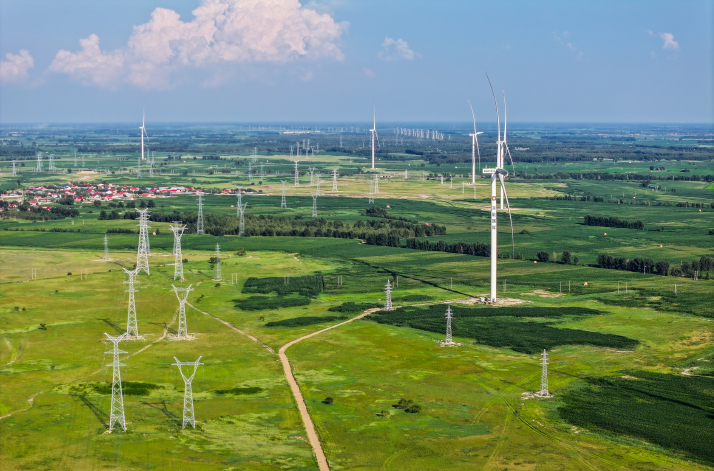| China |
| A clean connection | |
|
|
 A wind farm in Tongliao, Inner Mongolia Autonomous Region, on August 13, 2024 (XINHUA)
A few days before the seventh China International Import Expo (CIIE) opened in Shanghai on November 5, 2024, its organizers concluded a deal for 10,000 Green Electricity Certificates (GECs) with the Shanghai branch of China Huadian Corp., a state-owned power generator, via the green power exchange in Beijing. To be specific, each GEC is equivalent to 1,000 kilowatt-hours (kwh) of renewable energy. This purchase enabled the six-day CIIE to acquire 10 million kwh of green electricity, enough to achieve carbon neutrality and reduce emissions by 4,200 tons, thus making the once energy-intensive event more environmentally friendly. Green certificates serve as a "badge" for electricity from renewable energy sources. They are issued by national authorities to suppliers, usually clean energy companies, who can then sell them on trading platforms. The buyers, often companies that want to reduce their carbon footprint or fulfil their social responsibility obligations, participate in the energy transition by directly supporting the production and consumption of renewable energy in China. Effective instruments Since the announcement of China's dual carbon targets—to peak carbon emissions before 2030 and achieve carbon neutrality before 2060—in 2020, the country's development of renewable energy has accelerated dramatically. According to the National Energy Administration (NEA), China added 210 million kilowatts (kw) of renewable energy capacity in the first three quarters of 2024, an increase of 21 percent year on year and accounting for 86 percent of new power installations. During this period, electricity generation from renewable energy sources reached 2.51 trillion kwh, an increase of 20.9 percent and accounting for around 35.5 percent of total electricity generation. By September 2024, the installed capacity of renewable energy in China had reached 1.73 billion kw, an increase of 25 percent year on year. To support this growth, China has established two trading mechanisms: the GEC market and the green power market. Created in 2017, the GEC market allocates certificates to wind and solar energy producers and allows buyers to support these sources through voluntary purchases. In response to increasing demand from companies looking to reduce their emissions, a special market for green electricity transactions was introduced in 2021. In 2023, GEC transactions were expanded to include hydropower and other clean energy sources. These markets are powerful tools to support the country's low-carbon energy transition. As explained by Zhang Xiliang, Director of the Research Institute of Energy and Environmental Economics at Tsinghua University in Beijing, the main difference between the two markets lies in the actual use of the green electricity: In green electricity transactions, buyers receive both the electricity and the certificate, while in the GEC market, they only buy the certificate, thereby certifying their environmental contribution, even if they don't directly consume green electricity. New national regulations were introduced last August to standardize medium- and long-term electricity transactions. According to the NEA, 2.31 billion GECs had been issued by the end of September 2024, with 359 million certificates traded across the country, 185 million of which were linked to green electricity transactions. Companies are the main consumers of green electricity. According to the China Electricity Council, they cover a range of sectors, including conventional energy, telecommunications, chemicals, metallurgy and the Internet. Technology giants, companies involved in heavy industries and advanced manufacturers dominate the market. According to a report on China's green power markets issued by BloombergNEF, a research firm, Alibaba Group, China's largest green power buyer in 2023, had committed to buying 1,610 gigawatt-hours of green power for 2024. The five largest consumers had increased their consumption of green energy by almost 95 percent in 2024 compared to the previous year.  The Seventh China International Import Expo, held in Shanghai from November 5 to 10, 2024, is a carbon-neutral event supplied with 100-percent green electricity (XINHUA)
A win-win situation Cooperation between major energy-consuming regions and regions rich in renewable energy resources, such as Inner Mongolia and Xinjiang Uygur autonomous regions, is increasing. Thanks to green power trading systems, companies can benefit from the supply of clean energy. For example, Tianjin Bohua Chemical Development Co. Ltd., a chemical manufacturing firm based in Tianjin, purchased 20.64 million kwh of green electricity in 2023, which came from Inner Mongolia, a region with abundant wind energy. "This region has built a base for generating wind power for other provinces and cities in the country at a favorable price," Cheng Hui, deputy head of Bohua's production technology department, told local newspaper Tianjin Daily. In addition to their social responsibility in the fight against climate change, Chinese companies, especially exporters, are increasingly buying green power to remain competitive in the international market. Since the introduction of the Carbon Border Adjustment Mechanism (CBAM) by the European Union (EU) in October 2023, European customers have been demanding a reduced carbon footprint for imported products. In response, Chinese companies are adapting to these new expectations. Dalian No.1 Instrument Transformer Group, based in Dalian, Liaoning Province, purchased 1.5 million kwh of green electricity in August 2023 to reduce its emissions to meet the requirements of its European customers. "Thanks to these efforts, our carbon footprint has reduced significantly," Xu Dongquan, Director of the group's Environmental Safety Department, said. In 2023, the company was awarded the Green Factory title at the national level. Against the backdrop of the global energy transition, especially the introduction of rules such as the CBAM and the new EU regulations on batteries and battery waste, experts suggest that China needs to expand its renewable energy capacity to strengthen its international competitiveness. An advanced green energy market is believed to strengthen China's international recognition in this field. "On one hand, by buying and utilizing green energy, companies can meet the requirements of their international customers for clean energy in production and thus increase their attractiveness and competitiveness in the global market. On the other hand, this choice reflects a company's commitment to environmental protection and helps to build a positive international brand image and attract consumers and partners who are concerned about climate change," Wu Xiaodi, General Manager of Baoshan Iron & Steel Co. Ltd., one of China's leading steel companies, said. BR This article was first published in ChinAfrica magazine Copyedited by Elsbeth van Paridon Comments to yaobin@cicgamericas.com |
|
||||||||||||||||||||||||||||||
|